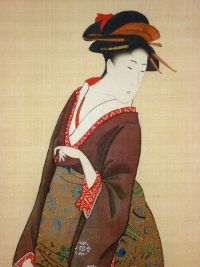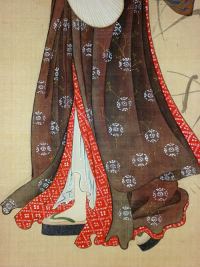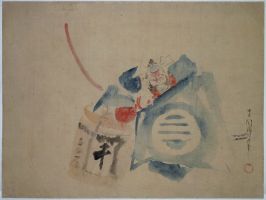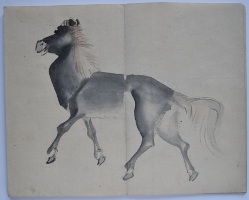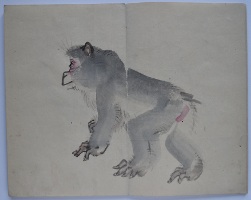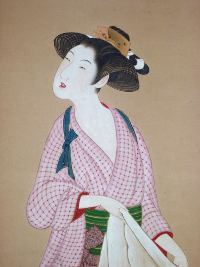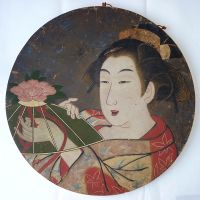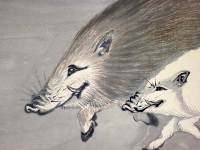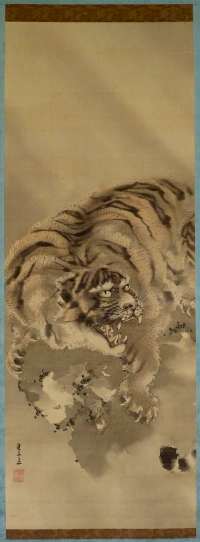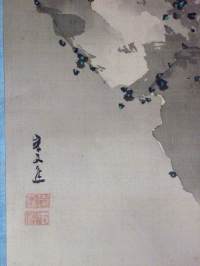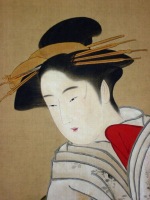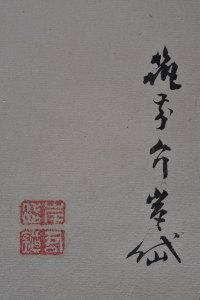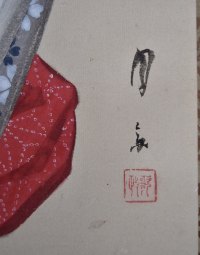/category/archive/page/3/
Katsushika HOKUSAI (1760-1849); Kyokutei BAKIN (1767-1848); Jippensha IKKU (1765-1831)
Click here to view image full size.
An original painting by Hokusai showing the back view of a courtesan. Above are inscriptions by Bakin and Ikku, the two leading writers of the day. ( Bakin is famous for writing Chronicles of the Eight Dog Heroes of the Satomi Clan of Nanso and Ikku for writing the most humorous book in the Japanese language: Shank’s Mare Journey on the Tokaido.) This painting was originally sold at the Tokyo Bijutsu Club, December 3rd, 1928. It is illustrated in Katsushika Hokusai Paintings, Mainich Shimbun, 1975. It is signed Toyo Katsushika Hokusai ga, “Painted by Katsushika Hokusai of Orient” and the seal, Katsushika Hokusai, is the same seal as that used on the pair of hand scrolls, Day and Night, in the Museum of Fine Arts, Boston. Colour and sumi on paper, 11.12 x 11.5 in; 28.2 x 29.2 cms. An intriguing old mount and sold with original sales slip from 1928 and a copy of the 1975 catalogue.
The inscriptions translate as:
I went out dressed up very lightly just to show off for the sake of cherry blossom viewing party.
However, I ended up catching a cold and all my efforts to enjoy the cherry blossoms went for nothing.
Jippensha Ikku
Yoshiwara is located in the north of Mount Kinryu, and it is a very grassy place.
Here I live inside the fence of Miuraya,
I am worshiped by so many guests.
Even though I devote myself completely to seek popularity every day,
I am a louse whose heart cannot be stolen by money alone.
This is my mettle as a courtesan.
Kyokutei Bakin
Status: Sold
Utagawa HARUSADA (1830-1887)
Click here to view image full size.
An exceptionally beautiful painting of a standing beauty by this pupil of Kuniyoshi. An ukiyo-e artist who worked in Kyoto. Real name Okamoto Syotaro. Full colour with touches of gold on silk. Image size 40.5 x 13.5 in; 102.8 x 34.2 cms. Very minor brown area otherwise in fine condition. Signed Harusada ga. Seal unread.
Status: Sold
Kubo SHUMMAN (1757-1820) and Kameda BOSAI (1752-1826)
Click here to view image full size.
An original painting showing a parading oiran on the first day of the eighth month, Hassaku (hachigatsu sakuhi). It was common on this day to wear a white kimono. This festival still takes place in the Gion quarters of Kyoto. The calligraphy, above, is by Bosai (Hosai), an amateur artist and noted scholar and writer. Full colour on silk, 35.25 x 12.5 in; 89.5 x 31.7 cms. In good condition. Signed Shumman painted by himself with Shumman seal.
Status: Sold
Takehara SHUNCHOSAI (Fl. c 1772-1818)
Click here to view image full size.
An original painting showing beauties enjoying the cool of the evening on the riverbank and shallows of the Komo-gawa in Kyoto. An exceptional and rare painting by an artist best known for his guides to Osaka and Kyoto, Miyako meisho zue and Naniwa no kagami, published 1778 and 1780. Full colour on silk, 51 x 19.75 in; 129.5 x 50.2 cms. In very good condition. Signed Bunsei tei inoshishi chushu hatsumikka kyoshinioite Shunchosai Takehara Nobushige. Painted 1818.
Status: Sold
Utagawa TOYOKUNI II (TOYOSHIGE) (1777-1835)
Click here to view image full size.
An original painting on paper, unmounted, showing Asahina Saburo (Wada no Saburo Yoshihide), a famous warrior of the early Kamakura period (1185-1333). Image size 11.5 x 15.5 in; 29.2 x 39.5 cms. Signed Toyokuni suichu hitsu, “Toyokuni painted while being drunk.”
Status: Sold
Matsumura KEIBUN (1779-1843)
Click here to view image full size.
A fine gajo, 10.75 x 6.75 in; 27 x 17 cms, folding out to 10.75 x 13.5 in; 27 x 34 cms. Consisting of 24 paintings in sumi and light colour of birds, animals and fish, starting with the Twelve Signs of the Zodiac: Rat; Ox; Tiger; Hare; Dragon; Snake; Horse; Goat; Ape; Cock; Dog; Boar. Keibun studied with his older brother Matsumura Goshun as well as Maruyama Okyo. Highly talented, especially in kachoga, and went on to consolidate the Shijo style. Original covers and title slip. End sheet signed by the original owner: Sichikudou, Naniwa (the place that was to become Osaka) with his seal. Another unidentified large seal inside front cover. Some slight wormage not affecting any image and some appropriate scuffing of covers; otherwise very good condition. Painted probably late 1830s.
Status: Sold
Tsukioka SETTEI (1710-1786)

Click here to view image full size.
A very fine large painting showing a standing beauty holding a cloth. At her feet is a fulling-block (kinuta) and several mallets. She looks skyward at the geese flying across the moon. One of the traditional symbols of autumn in Japan. There seems to have been a frisson in depicting these beauties fulling cloth near streams, as well as awabi divers and the women of Ohara collecting faggots. Settei produced many illustrated books but after around 1765 turned to painting beauties, courtesans and geishas. They are of the utmost refinement – the faces and limbs picked out in red, their costumes with areas of gold, and invariably have the wide lantern-locks (toro-bin) hairstyle. All these characteristics are found here. Full colour on paper, image size 48.75 x 18.25; 124 x 47.5 cms. Painting and mount in extremely good condition. The box comes with a registration form showing the work seems to have been put up for sale at the Tokyo Bijutsu Club in Tokyo about 70 or 80 years ago. Painted c 1770. Signed Shinten’o gihitsu (painted for amusement by Shinten’o). Seals Hokkyo Settei and Kidashi (family name).
Status: Sold
Tsukioka SETTEI (1710-1786)
Click here to view image full size.
An interesting large painting, full colour on paper mounted on a wooden frame, 25.5 in; 62cms in diameter showing a bust portrait of a beauty with elaborate coiffure holding a child and a rattle. Although not signed, the attribution is unquestionable, painted between 1767-1773 in Osaka. It appears to have been commissioned to hang in a hairdresser’s or cosmetic shop and has metal eyes at the top. The oxidised silver leaf background was meant to resemble a mirror and the idea of busts reflected in mirrors and silver grounds was later employed by Utamaro and Sharaku. Apart from silver, gold leaf and gum is applied. Such signboards appear in an illustrated book by Hasegawa Mitsunobu published in Osaka in 1752. This new discovery has been written about by Dr. Yamamoto Yukari in vol.27 of Minzoku Geijutsu (Ethno-Arts) in 2011. Minor surface marks all over but astonishingly good condition given their age and use. Extremely rare.
Status: Sold

Click here to view image full size.
Tsukioka SETTEI (1710-1786)
Click here to view image full size.
An interesting large painting, full colour on paper mounted on a wooden frame, 25.5 in; 62cms in diameter showing a bust portrait of a beauty with elaborate coiffure and holding a hat for a street festival. Although not signed, the attribution is unquestionable, painted between 1767-1773 in Osaka. It appears to have been commissioned to hang in a hairdresser’s or cosmetic shop and has metal eyes at the top. The oxidised silver leaf background was meant to resemble a mirror and the idea of busts reflected in mirrors and silver grounds was later employed by Utamaro and Sharaku. Besides silver, gum and raised painting is applied. Such signboards appear in an illustrated book by Hasegawa Mitsunobu published in Osaka in 1752. This new discovery has been written about by Dr. Yamamoto Yukari in vol.27 of Minzoku Geijutsu (Ethno-Arts) in 2011. Minor surface marks all over but astonishingly good condition given their age and use. Extremely rare.
Status: Available

Click here to view image full size.
Teisai HOKUBA (1771-1844)

Click here to view image full size.
An original painting on silk in full colour. Image size 36.5 x 13.5 in; 92.75 x 34.25 cms. A fine painting showing beauties from different social strata: A farmer’s wife; a courtesan; an elegant wife; and a Heian period court beauty. Hokuba was one of the earliest and best of Hokusai’s pupils. A printmaker, but only of surimono, book illustrator, and, most importantly, a fine painter. Above is a kyoka poem by Ota Nanpo (1749-1823), a famous poet and fiction writer. Silk slightly browned and minimal loss of some pigment but in otherwise good condition. Old mount: Would benefit from remounting. Painted Bunsei period, c. early 1820s.
Signed Teisai Hokuba ga with seals Hoku Ba.
Status: Sold
Utagawa KUNINAO (1793-1854)

Click here to view image full size.

Click here to view image full size.
A pair of original paintings: One showing a beauty being followed by her servant down a jetty into a waiting boat. He protects her with an umbrella in one hand and carries food on a tray with the other. The whole scene under heavy snow. The other painting shows a beauty composing a poem. Above a wild goose flies before a full moon. Probably originally two of three setsu-getsu-ka, “Snow, Moon, Flowers.” A theme popular with ukiyo-e artists and originally derived from China. Kuninao studied under Toyokuni and then Hokusai and is also known for many illustrated books. His paintings now rare. Each painting full colour on silk, image size 36.5 x 12.75 in; 92.5 x 32.5 cms. In excellent condition. Beautifully presented with new mounts. One painting signed Kohsoen hitsu with seal Shohzan.
Status: Sold
Utagawa HIROSHIGE (1826-1869)

Click here to view image full size.

Click here to view image full size.
A pair of original kakejiku with two paintings on each. Possibly from the front and back cover pages of a first edition “One Hundred Famous Views of Edo” set. Sumi and colour, image size of each painting 13.5 x 8.75 in; 34.25 x 22 cms. Shows top left a bowl with – possibly – turnips and a poem. Below a wicker basket and bowl with a miniature plum tree and an adonis plant (the most popular plants for the New Year). On the right, at the top are two chidori with poem and below a sake barrel and a plum branch. The bottom two paintings are signed Hiroshige with Ichiryusai seal. In fact, there is another version of the chidori painting associated with a painting of a kago and lantern illustrated in the exhibition catalogue, Hiroshige – A Poetic Ukiyo-e Artist, Fukushima Minpo, 1971, no. 16. These are also possibly from the ends of a first edition set of prints. Hiroshige and Hiroshige II were known to make these paintings, presumably for special clients. Provenance: Ex Takeoka Toyota collection (1844-1931). The box dated (Taisho 11, 1922) and guaranteed by him. He was a famous collector from the Meiji to early Showa era. Paintings and mounts in very good condition.
Status: Sold
Katsushika HOKUSAI (1760-1849)
Click here to view image full size.
A small original painting of an old sage (possibly the poet Saigyo Hoshi [1118-1190]) seated, holding a bamboo pole and with a large hat on his back. He looks up wistfully at a mountain range with what appears to be a hanging bridge over a gorge. Light colour on silk; predominantly the pink, brown and sumi tints he was fond of. Image size 7.5 x 5.75 in; 19 x 14.5 cms. Provenance: From the estate of Jeanne Nicole Ledoux, daughter of Jean Pierre Ledoux, who was the son of the famous ukiyo-e collector Louis V. Ledoux. Mounted as a kakemono. In good condition. Signed Hachijukyusai Manji hitsu, “Brush of old man Manji, aged eighty-nine years.” And with seal Hyaku (“Hundred”). A fan painting in the Museum of Fine Arts, Boston, acc. No. 11.7470, has the same seal and signature.
Status: Sold
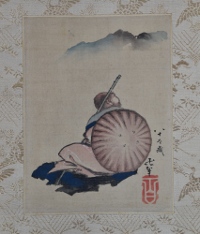
Click here to view image full size.
Tsukioka YOSHITOSHI (1839-1892)

Click here to view image full size.
An original painting, sumi and touches of red on paper, 26 x 11.5 in; 66 x 29.2 cms. A spontaneous painting of a beauty raising the hem of her kimono as she rushes to an appointment. Several small restorations only viewable obliquely, otherwise good condition.
Signed in cursive script which he used from 1887: Yoshitoshi ga. Small seal too indistinct to read.
Status: Sold

Click here to view image full size.
Hishikawa MORONOBU (C. 1618-1694)
Click here to view image full size.
An important figure and pioneer of the ukiyo-e school. He was born into a family of embroiderers and textile dyers at Hota in Awa Province, but departed for Edo, c. 1658, to study painting. A prolific artist, he illustrated a large number of books, as well as being the first to design single-sheet prints. Turned to painting c. 1670. Shows a promenading beauty, knees slightly bent and the long face typical of Moronobu. The delicately painted kimono has serrated roundels with images of Heian court life or abstract patterns interspersed with small gold flower heads.
An original painting on silk, image size 23.5 x 10.75 in; 59.75 x 27 cms with an old elaborately embroidered mount. Unsigned, as is often the case with 17th century paintings. In very good condition.
Status: Sold
Matsumura KEIBUN (1779-1843)

Click here to view image full size.
A handscroll comprising twelve mostly nature studies. ( Four shown. ): An isolated village; redstart and camellia; a rock; iris; rose; bamboo; lobster; sparrow and begonia; a village covered in snow; a scholar reading; white camellia; hibiscus. Sumi and light colour on paper, 14 x 441.2 in; 35.5 x 1120 cms. Keibun was a leading Kyoto artist who had many talented pupils. He studied with his older brother Matsumura Goshun and also Maruyama Okyo. The paintings show all the spontaneity and brevity of a leading exponent of the shijo school and the subject matter is typical. Minor marks; slight edge damage on one painting, but generally good condition. Each painting sealed Kei Bun . Ivory rollers and stickered box.
Status: Sold
Katsushika HOKUSAI (1760-1849)
Click here to view image full size.
An original painting by Hokusai showing wild boars, a parent and baby. Another “Wild Boar in the Moonlight” painting is in the Museum of Fine Arts, Boston, acc. No. 11.7430, ex William Sturgis Bigelow collection. The same broad background brushstroke shading is found on both paintings. Illustrated in Idemitsu Museum of Arts, vol. 9, Ukiyo-e Paintings, Kikuchi Sadao, 1976, pl. 84, p. 57. It was originally in the inventory of Yabumoto Soshiro, the largest antique dealer in Tokyo after he moved from Kyoto in the second half of the 20th century. Sumi and light colour on paper, 12.75 x 22 in; 32.4 x 56 cms. Signed Gakyorojin Manji hitsu rei hachi-ju-ichi (“at the age of 81”) with Fumoto-no-saki seal, so probably painted for the year of the boar, 1839. There are other paintings with the same signature and seal, e.g. The Harari Collection of Japanese Paintings and Drawings, volume 2, Jack Hillier, Lund Humphries, 1970, no. 142 “The Comet,” p. 258.
In very good condition. Recently remounted and sold with the old Edo-era box.
Status: Sold
Kishi RENZAN (1805-1859)
Click here to view image full size.
An original painting by Renzan, also known as Gantoku. He was adopted by the Kishi family and trained by his father-in-law, Kishi Ganku, who founded the Kishi school. His fellow pupils were Yokoyama Kazan and Minwa Bumpo. After Ganku’s death, he became the leader of the school together with Gantai. Highly regarded in Japan, he painted the walls of the Room of the Wild Geese in the Kyoto Imperial Palace. Shows a fierce tiger, very much in the style of Ganku. This subject is usually found as a diptych with a dragon. But this painting seems to stand alone and was probably painted for a year of the tiger, 1842 (?). Sumi and light colour on silk. 37 x 14 in.; 94 x 35.5 cms. Interestingly, Renzan designed a surimono of this subject also for a Tiger year, 1842 or 1854.
Signed Kishi Bunshin with upper seal Kishi Bunshin and lower seal unread. In good condition although mount somewhat creased.
Status: Sold
Teisai HOKUBA (1771-1844)
Click here to view image full size.
A large original painting, full colour on paper, 49 x 22.5 in; 124.5 x 57 cms. Shows a beauty caught in an autumnal breeze, the tree above shedding its leaves. One of Hokusai’s earliest and best pupils and, apart from painting , is also known for his surimono and book illustration. Famous for his meticulous paintings of beauties, Hokuba also produced these loose impromptu paintings using rapid brushstrokes. Painted in Bunka period (1804-1818).
Some slight rubbing of paper at top, but in surprisingly good condition given its size. Newly mounted. Signed Hokuba ga with Hokuba seal.
Status: Sold
Tsuji HOZAN (Fl. 1820-1840)

Click here to view image full size.
An original painting, 31.5 x 12.5 in; 80 x 31.8 cms. Sumi and full colour on silk. The inscription on the inside of the box lid states that the painting is by Tsuji Hozan, a Shijo painter, and shows a “castle-toppling” courtesan under cherry blossom in the style of Toyokuni. (Castle-toppling is a term used for high-ranking courtesans who could, because of their beauty, cause havoc and influence the regimes of men of great power. [See Yoshitoshi’s Women, John Stevenson, Avery Press, 1986, p. 48, no. 10, “Looking feminine” from the set “Thirty-two Aspects.”]) Hozan is known for the fine illustrations to Bitchu meisho-ko (1822) and there is a fine pair of paintings in the BM, acc. no. 1983.1111, 0.3.1-2. However, there is some thought that Hozan was a pseudonyme for Aoi Sokyu (Shuho). Certainly, this pure Ukiyo-e painting shows great competence. Signed Hozan hitsu with seals Hozan and Dojin. In fine condition. Also, on the inside of the lid is a guarantee from Zangetsu’an Studio.
Status: Sold
Kawamata TSUNEMASA (Fl. 1716-1751)

Click here to view image full size.
An original painting, sumi and full colour on paper, 27 x 10.5 in; 68.5 x 26.75 cms. Shows a parading courtesan with her kamuro. Tsunemasa’s small corpus of work shows him primarily painting portraits of beauties as well as mitate works alluding to classical themes. His delicate figures may have been an influence on Harunobu. Painted c 1745. In very good general condition. Signed Tsunamasa hitsu with Tsunemasa seal.
Status: Sold

Click here to view image full size.
Kitagawa UTAMARO II (Fl. c 1807-1830s)

Click here to view image full size.
An original painting, sumi and full colour on silk, 40.25 x 15.25 in; 102.25 x 38.75 cms. Shows a geisha reading a book and holding a shamisen likened to Manjusri (Japan: Monju), the bodhisattva of wisdom in Mahayana Buddhism. Often depicted riding or astride a lion representing the use of wisdom to tame the mind. As here where she straddles a large almost human-looking Shishi lion. Very few paintings by Utamaro II exist. See Bonhams auction, London 11/11/2010, lot 357. Also three bijin in Boston illustrated by Tsuji Nobuo in Nikuhitsu ukiyoe, Ukiyo-paintings: Museum of Fine Arts, Boston, Kodansha 2000, pl. nos. 6, 8, & 9. And a standing courtesan (yujo risshi zu) in the Tokyo National Museum, Japan. Viewing the paintings it’s evident Utamaro II was highly competent, not something we are aware of when comparing his prints to the work of Utamaro I, which are generally poor in comparison. Comes with a double-box, the second box inscribed “Painted by Utamaro II. A picture of a high-class geisha reading likened to Monju.” Inside the lid a guarantee from Kimura Suetsuke (a dealer and Ukiyo-e expert) dated 1979 (June of the sixth year of the sheep in the Showa period). Some slight loss of gofun but in good general condition. Signed Utamaro fude with two unread seals.
Status: Sold
Watanabe SEITEI ( 1852-1918 )
Click here to view image full size.
Seitei ( Shotei ) specialised in kachoga; was famous in this area, and regarded as the leading exponent. Technically brilliant. Shows two tancho ( “red crest” ) Japanese cranes flying down to a field suffused with the yellow of ripening rice. This crane ( Grus japonensis ) is the second rarest crane in the world, migrating to East Asia in the fall to spend the winter. There is also a resident flock in Hokkaido. Much loved by the Japanese, the crane was a symbol of luck, longevity and fidelity.Full colour on silk, 46 x 19.5 in; 117 x 49.5 cms. One small spot and minor loss of gofun on the rice, otherwise very good condition.
Signed and sealed Seitei. A beautiful composition.
Status: Sold
Katsukawa SHUNSHO ( 1726-1792 )
Click here to view image full size.
An extremely important painting by one of the most important artists of his day. One of the great ukiyo-e print designers – especially of actor prints. He lived in Edo and first studied under Katsukawa Shunsui and Ko Sukoku. Little is known of his private life. He had many able pupils including Hokusai. The seal he used had Hayashi on the side of a jar ( tsubo ), hence he was called Tsubo. In 1776, together with Kitao Shigemasa, illustrated the famous book Seiro bijin awase sugata kagami. Also the Ehon butai ogi with Buncho in 1770.
This was one of the paintings chosen to be exhibited at the Isetan Department Store to commemorate the Tokyo Olympics in 1964. The exhibit arranged by The Mainichi Newspapers. A committee consisting of Mr. Seiichiro Takahashi, president of the Japan Art Academy, Mr. Issho Tanaka, director of the Tokyo National Cultural Assets Research Institute, Mr. Seiroku Noma, an historian, Mr. Muneshige Narasaki, chairman of the Ukiyoe Association, Mr. Sadao Kikuchi of the Tokyo National Museum, Mr. Teruji Yoshida, an Ukiyoe connoisseur, Mr. Fusui Kaneko, an Ukiyoe connoisseur, Mr. Yasunosuke Ogiwara, an Ukiyoe connoisseur, and other collectors vetted all the paintings and they represented the best that could be put together at the time. Full colour on silk including gold leaf. Exquisitly painted. Slightly creased otherwise in good condition. Double box with inscription in gold. Image size 39 x 12.5 in; 99 x 31.75 cms. Painted c 1781-9.
Signed Katsu Shunsho ga with seal. Ex collection Oda Eisaku, a famous art dealer and collector.
Status: Sold
Kawamura BUMPO (1779-1821)

Click here to view image full size.
A pair of paintings, shosha and gyosha, a wood-chopper and fisherman in a mountainous landscape. Sumi on paper, image size 42.25 x 10.9 in; 108.3 x 27.7 cms. A highly talented Shijo painter and haiku poet who studied under Kishi Ganku and was much influenced by Chinese painting before developing his own individual style. Illustrated numerous ehon including Bumpo gafu, vols 1-3, 1807-13 (see following item); Kaido kyoka awase, 1811; Bumpo sansui gafu, 1824. Minor flaws but generally good condition. Each signed Bumpo with Nanzanju seal.
Status: Sold
Katsushika HOKUSAI (1760-1849)

Click here to view image full size.
An original painting showing the back view of a courtesan and her assistant. The poem is by Shokusanjin:
It is all because of you who is blooming,
flowers and the moon in this quarter seem prosperous
Shokusanjin
This appears to have been painted during his Sori period at a banquet held by the geisha house that Hokusai and Shokusanjin attended. In good condition having been recently remounted. Sumi and light colour on paper, 15.25 x 21.5 in; 38.7 x 54.6 cms. Signed Hokusai sekijyo, “Hokusai on this occasion.”
Seal unread: This is a seal used by Hokusai during this period as well as in his later years, but has not been deciphered.
Status: Sold
Ichiryusai HIROSHIGE (1797-1858)
Click here to view image full size.
An original painting, sumi on paper, 35 x 11 in; 88.9 x 28 cms. A view of Matsuchiyama from Imadobashi with bands of low lying mist. This area is depicted on many Hiroshige prints. Painted c. 1850. In very good condition. The mounting cloth is wasarasa, Japanese batik, made at about the same time as this painting was made.
Signed Hiroshige hitsu with Ichiryusai seal.
Status: Sold
Manjiro HOKUGA (Fl. early to mid 19th century)

Click here to view image full size.
A large original painting, full colour on silk, 11.5 x 34.5 in; 29.2 x 87.7 cms. Shows Tametomo, a famed archer of extraordinary strength who was exiled to Oshima by the Emperor. During his sojourn Tametomo discovered Onigashima, an island inhabited by devils who he subordinated. News of this reached the Emperor who sent a fleet of vessels to capture him. On sighting the nearest boat Tametomo fires an arrow and sinks the ship and three hundred men. There is a famous version of this subject painted by Hokusai in the BM (see Ukiyo-e Paintings in the British Museum, Timothy Clark, 1992, no. 96, p. 146). Hokuga, a pupil of Hokusai, specialised in surimono. Probably Hokuga’s masterpiece.
Silk slightly darkened, otherwise very good condition. Recently remounted. Signed Manjiro Hokuga with seals Hoku Ga.
Status: Sold
Utagawa KUNISADA (1786-1864)

Click here to view image full size.
A fine original fan painting showing a woman of Ohara; a mountain village north of Kyoto. These Oharame collected brushwood and firewood in the fall to sell in Kyoto. They are often depicted and obviously caused a stir when they entered Kyoto to ply their trade. The custom has evidently been going on since the 12th century. She is shown holding a flower and sitting on her bundle of firewood.
Full colour on prepared paper mounted as a fan, 6.5 x 17in; 16.5 x 43.2 cms (paper area). In very good condition. Signed Kunisada ga with indistinct seals, probably Kuni Sada. A charming painting.
Status: Sold

Click here to view image full size.
Katsushika HOKUSAI (1760-1849)

Click here to view image full size.
An original painting showing Hotei, the God of happiness and one of the Seven Gods of Good Luck (Shichi-fuku-jin). The corpulent Hotei reclines contentedly smoking a long pipe. Beside him is his huge bag (hotei literally means “cloth bag”) which contained the treasures and food he dispersed. Sumi and light colour on paper, 15.25 x 9 in; 38.5 x 23 cms. Presumably from a hand scroll. A spurious Hokusai seal to the right. Paper browned and soiled. Sold “as is” with all imperfections.
Status: Sold
Utagawa HIROSHIGE (1797-1858)

Click here to view image full size.
An original painting in sumi with touches of green and pale blue. Image size 50 x 17 in; 127 x 43.2 cms on paper. Shows the Mount Haruna area which also has Mount Myogi and Mount Akagi. Depicts the strange peaks surrounded by swirling mist and cloud. The region was formed more than 300,000 years ago in Gunma, eastern Honshu. Hiroshige designed a snow scene of the same area for the print set Sixty-odd Provinces of Japan published in 1853. Recently remounted and in very good condition. Signed Hiroshige ga with Ichiryusai seal.
Status: Sold

Click here to view image full size.
Ichiryusai HIROSHIGE (1797-1858)
A fine and important painting of the autumn moon at Ishiyama. Ishiyama Temple seen to the left and Seta Bridge to the right with Mount Fuji in the distance. The view is very close to that for the design Ishiyama no shugetsu, from the Omi Hakkei no uchi print set published c 1834 but the viewpoint moved round and slightly closer. The strange rocks which give their name to the temple are given prominence using a spontaneous brush. As with so much in Japan, the Eight Views theme comes from China and is based on the Eight Views of Xiaoxiang. Fine condition. Painted in sumi with light sumi and blue washes on ( the usual ) grey silk. Image size 16.25 x 23 in; 41.25 x 58.5 cms Fine new mount with futo-maki ( thick wooden roll to preserve the painting from damage ). New box. Signed Hiroshige with Ichiryusai seal.
Status: Sold
Katsushika HOKUSAI (1760-1849)

Click here to view image full size.
An original painting, light colour on paper, 13 x 16.5 in; 33 x 42 cms. Shows a sparrow flying over a flowering plum tree. Light soil and creasing, but in generally good condition. Signed Hokusai suichu hitsu, “Hokusai painted while drunk.” Sealed Katsushika. (One of his better-known seals. He used different versions of it throughout his career.)
Status: Sold

Click here to view image full size.
Tsukioka YOSHITOSHI (1839-1892)

Click here to view image full size.
An original fan painting, sumi on treated paper, 17.5 x 5.5 in; 44.5 x 14 cms. Shows two dogs – possibly Chin. In very good condition: As nearly always, showing the rib folds of the fan. Tipped onto gold-speckled board. Signed and sealed Yoshitoshi.
Status: Sold
Ichiryusai HIROSHIGE (1797-1858)
Click here to view image full size.
An original painting, sumi and very light blue on silk, 40 x 15.25 in; 101.6 x 38.7 cms. Shows the moon reflected in the Tama river with spring ayu (sweet water fish) swimming beneath Japanese papyrus growing in the water.
A beautiful painting. One small foxing mark, otherwise very good condition. Signed Hiroshige hitsu with Ichiryusai seal.
Status: Sold
Shibata GITO (1780-1819)
Click here to view image full size.
A fine Shijo handscroll, sumi and light colour on paper, 11.13 x 423.5 in; 28.26 cm x 10.76 metres. Gito was an early pupil of Goshun who, although he died young, produced enough work to show him to be a highly gifted artist with great ability in landscape, figure and kacho-e. Shows various Kyoto activities and festival preparations. Signed Gito utsusu with hand-drawn seals. There is also a dedication signed and dated, Bunka 8 (1811) February, by Kamono Suetaka (1754-1841) a scholar of Japanese philology and philosophy (Kokugakusha) and also a poet who lived in Kyoto and was presumably a friend of Gito.
Light edge stains, otherwise very good condition. These early quality handscrolls are now very difficult to find.
Status: Sold
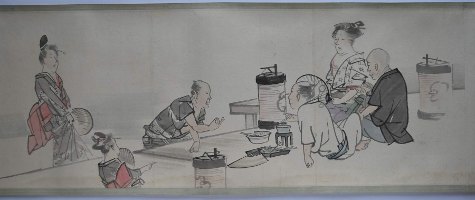
Click here to view image full size.

Click here to view image full size.

Click here to view image full size.

here to view image full size.
Kubo SHUNMAN (1757-1820)
Click here to view image full size.
An original painting showing a sparrow taunting a horned owl. Shunman, a man of great sophistication, produced few prints (indeed, as Jack Hillier pointed out [The Japanese Print: A New Approach, pp. 102-104]: “Probably no artist except Choki has achieved so high a reputation on such a small number of prints.”); but is known for his fine surimono. Also excelled at writing, light verse, book illustration and painting of mainly bijin, making the subject matter here rare for him. However, the subject was also used for a surimono by him showing an owl on a flowering magnolia branch. Sumi and the characteristically light and subtle use of colour on silk, 36 x 11.5 in; 91.5 x 29.2 cms. Inscription above by Rosanjin. In very good condition having been remounted. Signed and sealed Shunman.
Status: Sold
Shibata ZESHIN (1807-1891)
Click here to view image full size.
An original painting of a somewhat benign Raijin, the god of thunder and lightening. His geta are on a shelf and a cat watches him. There appears to be a cloth-covered mirror at the extreme left. This could almost be some sort of green room view. Zeshin was the greatest lacquerer of the 19th century. Also a highly skilled painter, often using lacquer on his paintings. Sumi on creped silk, 32.25 x 6 in; 81.9 x 15.2 cms. A diagonal joining of two pieces of the silk make up the length. In good condition. Signed Zeshin with largeTairyukyo seal. Painted c. 1885.
Status: Sold
Click here to view image full size.
Kishi GANTAI (1782-1865)
Click here to view image full size.
A superb large gajo (11 x 8 in; 28 x 20.4 cms) of tour de force paintings folding out to comprise: 30 two-sheet designs; 14 four-sheet designs; 2 six-sheet designs; 1 eight-sheet design, making a total of 136 sheets in sumi and light colour on paper. Gantai was the son and pupil of Ganku, and together with his brother, Renzan, carried on the Kishi school tradition. With his father, worked on the paintings for the new Kanazawa Castle in 1809. A highly accomplished painter, especially of kachoga. A variety of subjects are covered in this album, many of them the standard repertoire required of such artists to show their skill. In extremely good condition with high quality boards and gold end papers. Signed Chikuzennosuke Gantai with seals Gantai and Kunchin. See also the large deer painting on this update.
Status: Sold
Click here to view image full size.
Click here to view image full size.
Click here to view image full size.
Numata GESSAI (UTAMASA) (1787-1864)
Click here to view image full size.
An original painting showing a geisha looking back over her shoulder as though surprised. The kimono is beautifully painted with waves and cherry blossom in gofun. Full colour on paper, 50 x 20.25 in; 127 x 51.4 cms. He first studied under Maki Bokusen, then Hokusai during his stay in Nagoya. In the 1840s he was a pupil of Cho Gessho finishing by studying the nanga manner under Yamamoto Baiitsu. Another example is in the MFA, acc no. 11.7340, ex William Sturgis Bigelow collection. In very good condition and newly mounted. Signed Gessai with seal Utamasa.
Status: Sold
Click here to view image full size.






